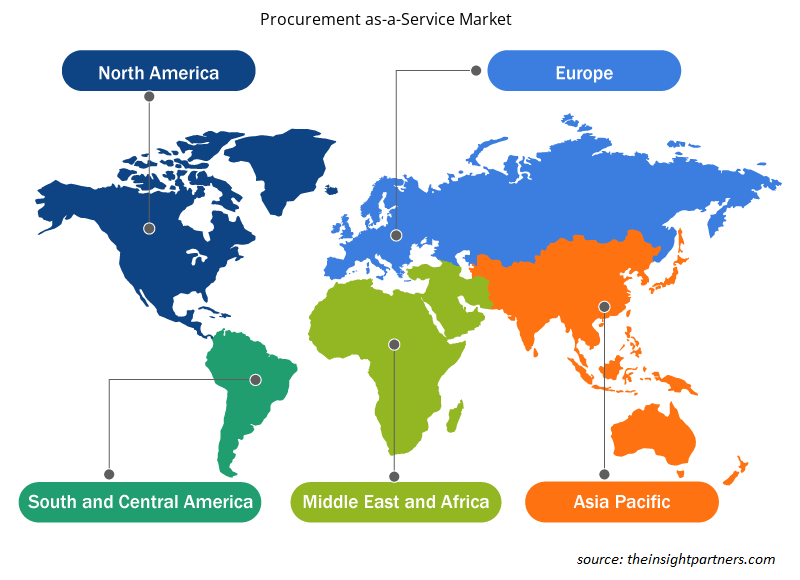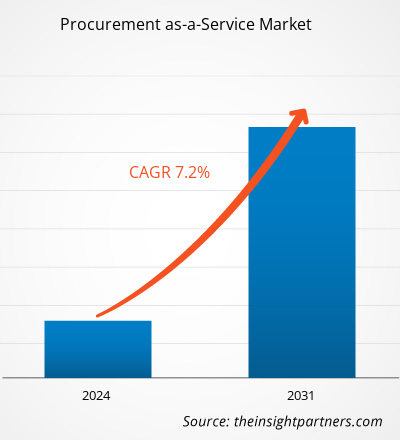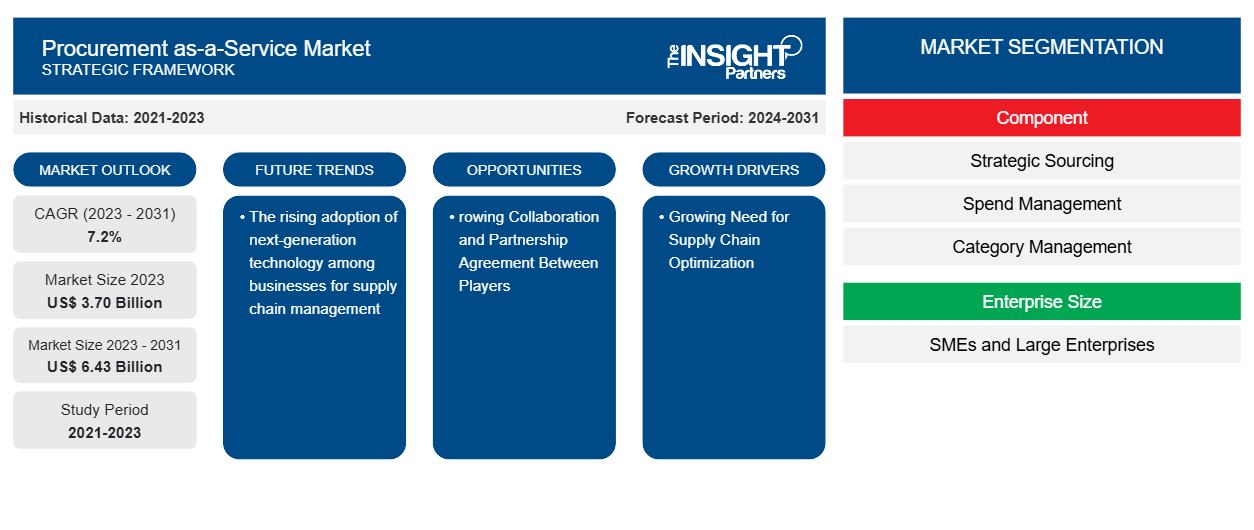Si prevede che la dimensione del mercato Procurement as-a-Service raggiungerà i 6,43 miliardi di dollari entro il 2031, rispetto ai 3,70 miliardi di dollari del 2023. Si prevede che il mercato registrerà un CAGR del 7,2% nel 2023-2031. La crescente adozione di tecnologie di nuova generazione tra le aziende per la gestione della supply chain rimarrà probabilmente una tendenza chiave del mercato Procurement as-a-Service.
Analisi di mercato dell'approvvigionamento come servizio
Il mercato del procurement as-a-service sta crescendo a un ritmo rapido a causa della crescente necessità di ottimizzazione della supply chain e del crescente numero di attività di importazione ed esportazione in tutto il mondo. Il mercato si sta espandendo costantemente, guidato dalle iniziative governative per promuovere la digitalizzazione per automatizzare il flusso di lavoro. Inoltre, la crescente collaborazione e l'accordo di partnership tra i player sta offrendo opportunità redditizie per la crescita del mercato.
Panoramica del mercato degli acquisti come servizio
Procurement as a service (PaaS) è un modello per l'outsourcing degli acquisti che combina risorse (persone, strumenti e conoscenze) per soddisfare i requisiti di acquisto di un'organizzazione. Molte organizzazioni oggi utilizzano i computer per gestire l'intero processo di acquisto, dalla richiesta iniziale alla fattura finale. Inoltre, le tecnologie dirompenti vengono utilizzate negli acquisti digitali per facilitare l'automazione delle transazioni. Inoltre, consente operazioni predittive e proattive come l'approvvigionamento strategico e la gestione dei fornitori, che riducono le spese operative di un'organizzazione. La crescente necessità aziendale di semplificare le operazioni di acquisto con la gestione delle normative e dei contratti di conformità sta guidando il mercato.
Personalizza questo report in base alle tue esigenze
Riceverai la personalizzazione gratuita di qualsiasi report, comprese parti di questo report, o analisi a livello nazionale, pacchetto dati Excel, oltre a usufruire di grandi offerte e sconti per start-up e università
-
Scopri le principali tendenze di mercato in questo rapporto.Questo campione GRATUITO includerà analisi di dati che spaziano dalle tendenze di mercato alle stime e alle previsioni.
Driver e opportunità del mercato degli acquisti come servizio
Crescente necessità di ottimizzazione della supply chain
I responsabili della supply chain adottano ampiamente i servizi di gestione degli acquisti per monitorare le operazioni complessive della supply chain. Questi servizi consentono ai responsabili della supply chain di anticipare in modo significativo potenziali problemi nella supply chain e riallocare le risorse di conseguenza. Inoltre, l'approvvigionamento come servizio è in grado di generare soluzioni affidabili basate sui dati che vengono utilizzate per migliorare l'efficienza dei processi aziendali. Il software di gestione degli acquisti offre sistemi di gestione dei processi basati sulle eccezioni che aiutano gli utenti a gestire le operazioni in stato stazionario e ad aumentare la visibilità interfunzionale. Di conseguenza, i consumatori investono sempre di più nel software di gestione degli acquisti per mantenere la trasparenza nella supply chain, la divulgazione degli ordini e i dati di spedizione.
Crescente collaborazione e accordo di partnership tra i player: un’opportunità nel mercato degli acquisti come servizio
Il progresso tecnologico e la crescente domanda di cloud computing , AI, analisi dei dati e tecnologia ML tra gli operatori di mercato per migliorare le loro offerte di servizi stanno creando opportunità nel mercato. Inoltre, la crescente domanda di servizi tecnologicamente avanzati tra i consumatori incoraggia gli operatori di mercato a sviluppare soluzioni innovative o ad aggiungere funzionalità ai loro portafogli esistenti. Ad esempio, a novembre 2022, Corbus, LLC ha firmato un accordo di partnership per l'approvvigionamento della supply chain con GIS per sviluppare soluzioni uniche. Questa partnership supporta GIS nella fornitura di infrastrutture e risorse ai clienti in Europa, America Latina, Nord America, Asia, Medio Oriente e Africa.
Analisi della segmentazione del rapporto di mercato Procurement as-a-Service
I segmenti chiave che hanno contribuito alla derivazione dell'analisi di mercato del procurement as-a-service sono i componenti, le dimensioni dell'impresa e l'utente finale.
- In base al componente, il mercato è segmentato in sourcing strategico, gestione della spesa, gestione delle categorie, gestione dei processi, gestione dei contratti e gestione delle transazioni. Il segmento di gestione della spesa ha detenuto una quota di mercato maggiore nel 2023.
- In termini di dimensioni aziendali, il mercato è diviso in PMI e grandi imprese. Il segmento delle grandi imprese ha detenuto una quota di mercato maggiore nel 2023.
- Sulla base dell'utente finale, il mercato è segmentato in IT e telecomunicazioni, beni di consumo e vendita al dettaglio, produzione, energia e servizi di pubblica utilità, assistenza sanitaria, ospitalità e turismo e altri. Il segmento manifatturiero ha detenuto la quota maggiore del mercato nel 2023.
Analisi della quota di mercato del Procurement as-a-Service per area geografica
L'ambito geografico del rapporto sul mercato degli acquisti come servizio è suddiviso principalmente in cinque regioni: Nord America, Asia Pacifico, Europa, Medio Oriente e Africa e Sud America/Sud e Centro America.
In termini di fatturato, il Nord America ha rappresentato la quota di mercato più grande del procurement as-a-service, grazie al progresso tecnologico e all'integrazione di AI, blockchain e altre tecnologie per migliorare la supply chain. Un significativo investimento governativo per promuovere la digitalizzazione delle aziende sta alimentando il mercato nella regione. La crescente digitalizzazione incoraggia gli operatori di mercato ad adottare tecnologie digitali per semplificare i loro processi di procurement e sta alimentando il mercato nel Nord America.
Approfondimenti regionali sul mercato degli appalti come servizi
Le tendenze regionali e i fattori che influenzano il Procurement as-a-Service Market durante il periodo di previsione sono stati ampiamente spiegati dagli analisti di Insight Partners. Questa sezione discute anche i segmenti e la geografia del Procurement as-a-Service Market in Nord America, Europa, Asia Pacifico, Medio Oriente e Africa, e Sud e Centro America.

- Ottieni i dati specifici regionali per il mercato degli acquisti come servizio
Ambito del rapporto di mercato sugli acquisti come servizi
| Attributo del report | Dettagli |
|---|---|
| Dimensioni del mercato nel 2023 | 3,70 miliardi di dollari USA |
| Dimensioni del mercato entro il 2031 | 6,43 miliardi di dollari USA |
| CAGR globale (2023-2031) | 7,2% |
| Dati storici | 2021-2023 |
| Periodo di previsione | 2024-2031 |
| Segmenti coperti |
Per componente
|
| Regioni e Paesi coperti |
America del Nord
|
| Leader di mercato e profili aziendali chiave |
|
Densità degli attori del mercato del Procurement as-a-Service: comprendere il suo impatto sulle dinamiche aziendali
Il mercato del Procurement as-a-Service Market sta crescendo rapidamente, spinto dalla crescente domanda degli utenti finali dovuta a fattori quali l'evoluzione delle preferenze dei consumatori, i progressi tecnologici e una maggiore consapevolezza dei vantaggi del prodotto. Con l'aumento della domanda, le aziende stanno ampliando le loro offerte, innovando per soddisfare le esigenze dei consumatori e capitalizzando sulle tendenze emergenti, il che alimenta ulteriormente la crescita del mercato.
La densità degli operatori di mercato si riferisce alla distribuzione di aziende o società che operano in un particolare mercato o settore. Indica quanti concorrenti (operatori di mercato) sono presenti in un dato spazio di mercato in relazione alle sue dimensioni o al valore di mercato totale.
Le principali aziende che operano nel mercato del Procurement as-a-Service sono:
- Accentura
- CAPGEMINI SE
- Corbo
- Società a responsabilità limitata
- Società anonima
- GEP
Disclaimer : le aziende elencate sopra non sono classificate secondo un ordine particolare.

- Ottieni una panoramica dei principali attori del mercato Procurement as-a-Service
Notizie di mercato e sviluppi recenti dell'approvvigionamento come servizio
Il mercato del procurement as-a-service viene valutato raccogliendo dati qualitativi e quantitativi dopo la ricerca primaria e secondaria, che include importanti pubblicazioni aziendali, dati associativi e database. Di seguito è riportato un elenco degli sviluppi nel mercato del procurement as-a-service e delle strategie:
- Nel febbraio 2024, Vodafone Group Plc e International Machine Business Corp collaboreranno a livello di settore, guidando la GSMA Post-Quantum Telco Network Taskforce, che supporterà i loro partner e clienti nel loro percorso verso la sicurezza quantistica, in particolare poiché la crittografia post-quantistica viene adottata nell'intera catena di fornitura delle telecomunicazioni globali . (Fonte: Vodafone Group Plc, comunicato stampa, 2024)
Copertura e risultati del rapporto di mercato Procurement as-a-Service
Il rapporto “Dimensioni e previsioni del mercato Procurement as-a-Service (2021-2031)” fornisce un’analisi dettagliata del mercato che copre le seguenti aree:
- Dimensioni e previsioni del mercato a livello globale, regionale e nazionale per tutti i segmenti di mercato chiave coperti dall'ambito
- Dinamiche di mercato come fattori trainanti, vincoli e opportunità chiave
- Principali tendenze future
- Analisi dettagliata delle cinque forze PEST/Porter e SWOT
- Analisi di mercato globale e regionale che copre le principali tendenze di mercato, i principali attori, le normative e gli sviluppi recenti del mercato
- Analisi del panorama industriale e della concorrenza che copre la concentrazione del mercato, l'analisi della mappa di calore, i principali attori e gli sviluppi recenti
- Profili aziendali dettagliati
- Analisi storica (2 anni), anno base, previsione (7 anni) con CAGR
- Analisi PEST e SWOT
- Valore/volume delle dimensioni del mercato - Globale, Regionale, Nazionale
- Industria e panorama competitivo
- Set di dati Excel
Report recenti
Testimonianze
Motivo dell'acquisto
- Processo decisionale informato
- Comprensione delle dinamiche di mercato
- Analisi competitiva
- Analisi dei clienti
- Previsioni di mercato
- Mitigazione del rischio
- Pianificazione strategica
- Giustificazione degli investimenti
- Identificazione dei mercati emergenti
- Miglioramento delle strategie di marketing
- Aumento dell'efficienza operativa
- Allineamento alle tendenze normative























 Ottieni un campione gratuito per - Mercato degli appalti come servizio
Ottieni un campione gratuito per - Mercato degli appalti come servizio